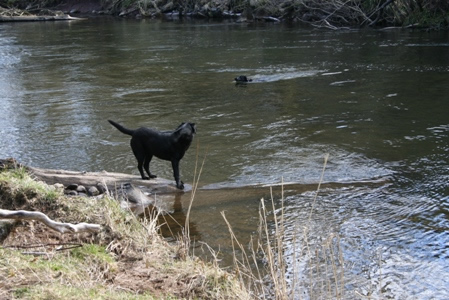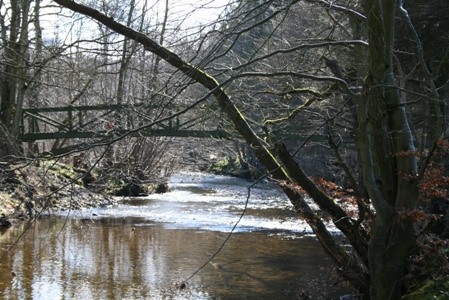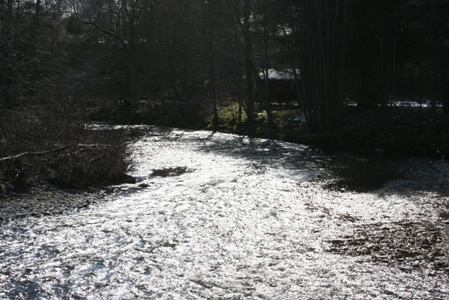These bulletin blogs represent news about Finavon and the South Esk, and my views as a riparian owner. They are not the views of any other organisation, nor are they designed to promote the interests of any individual or organisation other than Finavon Castle Water and factors affecting the fishery. Tony Andrews
On Saturday I walked the whole of FCW with the dogs, unusually for me without a rod. The water was cold with a slightly milky colouring from snowmelt and the sun was shining brightly, well, most of the time. The air temperature was about 5C.
Presumably labradors are used to icy waters. I am not sure whether it is true that these dogs were used originally to help set nets in the sea by swimming the leader ropes to the fishermen, who then drew in the moving net. The enthusiasm my two black labradors show for a cold swim is different and an indication of their characters. The onlooker (as is her wont) is Tinca, a laid back animal if ever there was one, and the swimmer, enthusiastic and intrepid, is her sibling, Tally. Both animals are great company for an ageing fisherman!
The aqueduct has now completed its transformation from pipe bridge to footbridge after Will Wells and the Scottish Oak team (they are the people who built the magical ‘Monet-style’ footbridge at Red Brae – see photo below) installed handrails on both sides of the central concrete girder. The result is a bridge that feels safe, although there is still work to be done to protect its foundations on the south bank from further erosion.
I saw one fish in the lie at the head of Haughs (Bogardo Beat). I am fairly certain this was a fresh salmon of about 12lbs. My guess is based on a) the position of the fish, holding station in the stream, which kelts usually avoid b) the thick-set, solid profile of the fish which was lying in about 4′ of water downstream of the aqueduct. It was therefore easy to see because I was directly above it. Judging by the water temperatures over the last four weeks I doubt whether many salmon will have reached FCW, so this is proably a lead scout in what we are all hoping will become a substantial spring run.
The gradient between the suspension bridge and Craigo Stream (photo above) is one of the steepest in the middle South Esk. This very fast stream, running down a narrow channel, requires an effort for salmon to ascend in cold water temperatures, which may explain why fish tend to hold up in the relatively calm and deeper water of the Boat Pool.
As I said in the previous blog, it is encouraging to see that Upper Kinnaird is the leading beat on both Esks (as declared in Fishpal’s reports). This is the proof we need that the spring run on the South Esk is not dead, but we should not construe too much from the 22 salmon so far reported from Kinnaird’s beats. There are two reasons for that comment 1) Some fish may go back to sea after deciding they want to be in another river 2) The fish caught at Kinnaird may represent a high proportion of the South Esk’s spring run to date, on the grounds that low water temperatures are effectively holding them downstream of the Upper Kinnaird dyke.
Next blog: Some thoughts on how to solve the problem of erosion downstream of the aqueduct and a request to my readers for some ideas on how to deal with it. And, who knows? Maybe our first fish of 2013, later than usual this year.
TA


